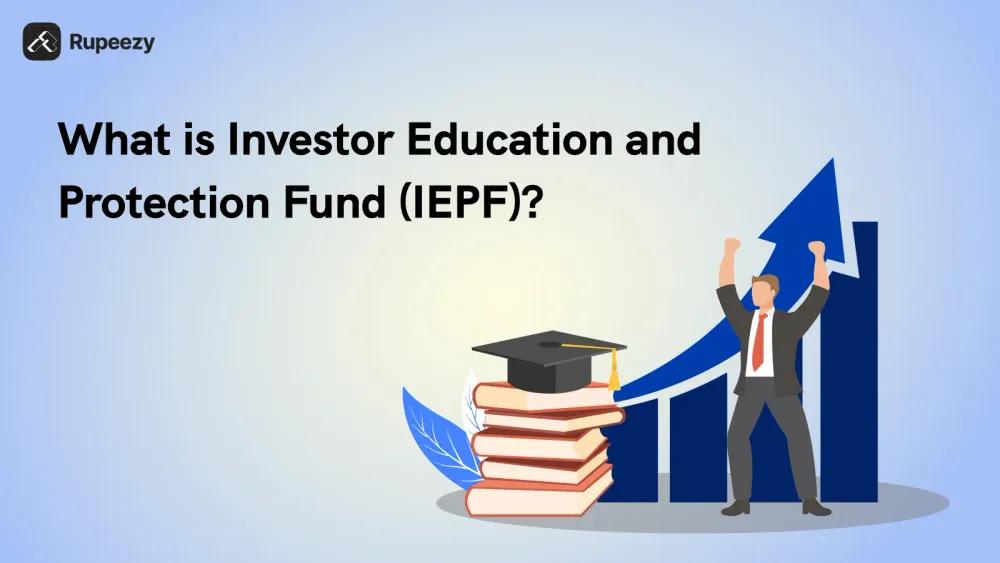Investor Education and Protection Fund (IEPF): Complete Guide


00:00 / 00:00
In the past, whenever a company announced dividends, the associated bank would send a cheque to the investor's home to process the claim. However, many investors would forget about their claim or misplace their cheque, which prevented them from receiving the dividend. Today, even a small amount of the dividend is transferred electronically to our account right away. But still, some dividends go unnoticed, and here is where the Investor Education and Protection Fund (IEPF) comes into the picture, which is crucial in safeguarding investors' interests and making sure their invested funds are not lost.
In this article, we will understand what the Investor Education and Protection Fund (IEPF) is, the purpose of its creation, and how an IEPF claim for dividends or shares is made. So let’s dive in!
What is Investor Education and Protection Fund (IEPF)
The Investor Education and Protection Fund (IEPF) is a government-backed initiative that holds unclaimed dividends, shares, and deposits that remain inactive for over 7 years. It allows rightful investors to reclaim these assets through a structured process.
Established under Section 205C of the Companies Act, 1956, and later under Section 125 of the Companies Act, 2013, IEPF is administered by the Investor Education and Protection Fund Authority (IEPFA) under the Ministry of Corporate Affairs, India.
IEPF pools unclaimed amounts such as:
Dividends from mature deposits
Interests from debentures and share applications
Unclaimed funds from AMCs and other sources
These are held securely until claimed by investors. If you have unclaimed dividends, matured deposits, or forgotten shares, you can file a claim through the official IEPF portal. The process is simple, structured, and aims to return rightful assets efficiently.
What Is the Purpose of the Investor Education and Protection Fund
Initially, the IEPF was established to utilize unclaimed investor funds for initiatives that benefit investors, such as conducting financial education and awareness programs. It also supports the objectives outlined in the Investor Charter, which aims to empower individuals through transparency, financial literacy, and responsible investing. Additionally, the IEPF provides a systematic process for investors to initiate an IEPF claim and recover their unclaimed dividends, shares, or other investments. In 2016, the government made it compulsory to transfer shares that had unclaimed dividends for the past seven consecutive years. This confused stakeholders, so the Ministry of Corporate Affairs (MCA) amended it several times to simplify the process.
How IEPF Protects Investors in India
Now that we have a basic understanding of this organisation, let’s explore some objectives of the Investor Education and Protection Fund (IEPF) that work to protect investors.
It teaches investors about the volatility of the markets so that they can understand the benefits and risks associated with investors’ decisions.
IEPF also promotes research and conducts surveys to spread knowledge among investors.
They educate investors on how to assess the market, understand financial risks, and make informed decisions, especially when dealing with matters like IEPF unclaimed dividends and long-forgotten investments
Making sure that investors are aware of their legal rights and the laws regarding investing.
Who Can Apply for a Refund From the IEPF?
Those Investors who have any unclaimed funds, such as dividends or debentures, for 7 consecutive years are eligible to initiate an IEPF claim. Below are the categories of individuals who can apply for a refund from the IEPF:
Shareholders: In the case of shareholders, if their dividends or shares are transferred to the IEPF and if they fail to claim within 7 years, then they can claim a refund from the IEPF.
Legal Nominees: After the death of a shareholder, his/her legal nominee can claim the securities, like shares and debentures, if they have been transferred to the IEPF.
Debenture or Bondholders: When an individual holds securities, such as bonds or debentures, he/she can claim them by transferring to the IEPF.
How IEPF Claim Is Done for Dividends, Shares, and Deposits
Let us understand how you can file for an IEPF claim by following this step-by-step procedure, as mentioned in the points below:
Step 1: Visit the IEPF Website
If you have any unclaimed shares, dividends, or any other securities, you can visit the IEPF Website under the MCA portal.
Step 2: Fill Web Form (IEPF-5)
On the website, click on ‘Web Form IEPF-5’ to fill out the form through the MCA portal. After completing the form, save it to your device. Don’t forget to read the instructions for filling out the IEPF-5 before you begin.
Step 3: Upload the Form
After filling out all of the required information, you can submit it by uploading the IEPF-5 by clicking the ‘Upload e-form’ option under the ‘Forms’ tab. After successfully submitting the form, an acknowledgment receipt with the Service Request Number (SRN) will be generated.
Step 4: Save SRN & Print Form
Save the SRN to keep track of the form's status. Then, you can print out the completed IEPF-5 and the acknowledgement issued for future purposes.
Step 5: Submit Documents to Company
Then, submit the relevant documentation, such as an indemnity bond, a copy of the acknowledgement, and the IEPF-5 form, to the company's nodal officer at its registered office in an envelope labelled "Claim for refund from IEPF Authority."
Step 6: Await Verification & Refund
You can now claim after completing the forms, and the concerned authority will verify them. Based on the verification report, the IEPF Authority will provide a refund to the claimant’s account through electronic transfer.
Documents Required for an IEPF Claim
Some important documents are required for an IEPF claim. The following points list the necessary documents that must be presented to the IEPF:
Filed IEPF-5 form and acknowledgement: After you file for a claim, an acknowledgement will be issued by the MCA, which will consist of a unique serial number that is used for tracking the status of your claim.
Original Indemnity Bond: The stamp duty law requires you to sign an original indemnity bond on stamp paper of appropriate value. The e-form IEPF-5, which can be downloaded from the IEPF website, contains the format for this bond.
Documents to Shares or Debentures Held: You would need to provide an original debenture or share certificate if you hold these securities in physical form, and then submit a transaction statement.
Entitlement proof: You must submit any document that proves your entitlement to the security you wish to claim, such as a dividend warrant or a share certificate.
Identity proof: A copy of your Aadhar card, passport, or driving license is required to be submitted if you are an Indian citizen. If you are an NRI, you need to give a copy of your OCI (Overseas Citizen of India) and PIO (Person of Indian Origin) card.
Cancelled Cheque leaf: It should be in your name and show your bank account number where the refund of the dividend amount needs to be sent.
Death Certificate and Notarised Affidavit: If the shareholder passed away and the legal nominee is making the claim, then the nominee needs to submit the death certificate of the shareholder and get a notarised affidavit that shows the relationship with the shareholder who passed away.
Duty Executed Transmission Request Form: The form is required if the shares need to be transferred from the deceased shareholder's account to their legal nominee account.
Client Master List (CML): You are required to get this document from the depository participant, which should include all the details of your demat account.
IEPF vs SEBI
Now that we have looked at the steps to claim refunds from IEPF, let us have a look at the table below showing the differences between IEPF and SEBI:
Aspects | IEPF | SEBI |
Meaning | It is a statutory body that promotes investors' awareness and protects their interests, particularly for long-unclaimed investments. | It is a regulatory agency established by the Indian government in 1992 to oversee and develop the securities market. |
Full form | IEPF stands for Investor Education and Protection Fund | SEBI is an acronym that stands for the Securities and Exchange Board of India. |
Purpose | The IEPF’s primary purpose is to return unclaimed securities such as debentures, shares, and so on. | The primary purpose of SEBI is to protect investors’ interests and encourage the development of the securities market. |
Established | It is governed by the Ministry of Corporate Affairs (MCA) under Section 125 of the Companies Act 2013. | It was formed by the Government of India in 1988 as a non-statutory body, and later it became a statutory body in 1992 under the SEBI Act, 1992. |
Conclusion
To sum up, the Investor Education and Protection Fund (IEPF) gives investors an opportunity to reclaim their rewards, and it assists them in remaining informed and conscious of their financial decisions. It serves as a reminder that, even if you have forgotten about the money you invested, money still matters.
FAQs:
Q1. Who is the CEO of the Investor Education and Protection Fund?
The chief executive officer of the Investor Education and Protection Fund in India is Anita Shah Akella.
Q2. Which organisation has established the Investor Education Protection Fund?
In India, the Investor Education and Protection Fund is established by the Ministry of Corporate Affairs.
Q3. Why is investor education important?
Investor education is important because it assists investors in achieving financial security and stability to make sound financial decisions.
Q4. What is the maximum limit of the investor protection fund?
The maximum limit of the investor protection fund is Rs 35 lakhs per investor, defaulter, or expelled member.
Q5. What Happens to Unclaimed Shares and Dividends?
The unclaimed shares and dividends are transferred to the IEPF after 7 years according to Section 124 (5) of the Companies Act 2013.
Q6. How Long Does It Take to Get Money from IEPF?
The processing time is dependent on the IEPF Authority’s verification and the company.
Check Out These Related Articles |
The content on this blog is for educational purposes only and should not be considered investment advice. While we strive for accuracy, some information may contain errors or delays in updates.
Mentions of stocks or investment products are solely for informational purposes and do not constitute recommendations. Investors should conduct their own research before making any decisions.
Investing in financial markets are subject to market risks, and past performance does not guarantee future results. It is advisable to consult a qualified financial professional, review official documents, and verify information independently before making investment decisions.

All Category










